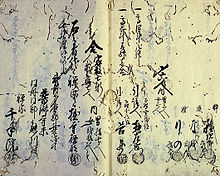Danka system

In the Danka system ( Japanese 檀 家 制度 , danka seido ), also known as the Jidan system ( 寺 檀 制度 jidan seido ), households (the danka ) in Japan supported the local Buddhist temple financially. In exchange for this, the respective temple granted support in spiritual terms.
Even if this system had been known since the Heian period , its repressive side was only fully used during the Tokugawa regime of the Edo period . It was during this time that the registration of every household with a Buddhist temple became mandatory. Comparable to a residents' registration office, this served on the one hand to control the population and on the other hand to prevent the spread of Christianity in Japan . So-called Terauke ( 寺 請 ) were issued as a kind of certificate for registration , which thus also served as proof that the citizen in question was not a Christian. For this reason, this procedure is also known as the Terauke system ( 寺 請 制度 , terauke seido ), since the temple ( tera ) issued the certificate ( uke ). The Terauke were collected by the local authorities in the "Register of Religious Affiliation " ( 宗 門 人 別 改 帳 shūmon ninbetsu aratamechō ), with the system having its own authority ( 宗 門 改 役 shūmon aratame yaku ) with the commissioner for religious questions ( 宗 門 奉行 shūmon bugyō ) Board.
Although this mandatory system was abolished after the end of World War II, it has remained in place on a voluntary basis to this day and represents an important part of the financial security for the respective temples.
literature
- Marcure, Kenneth (1985). "The Danka System". Monumenta Nipponica 40 (1): 39-67.
- Tamamuro Fumio: Local Society and the Temple-Parishioner Relationship within the Bakufu's Governance Structure. ( Memento from July 22, 2011 in the Internet Archive ) In: Japanese Journal of Religious Studies. 28 / 3-4 (2001), pp. 261-292.
- Tamamuro Fumio: The Development of the Temple-Parishioner System ( October 19, 2015 memento in the Internet Archive ), Japanese Journal of Religious Studies 36/1: 11–26, 2009
- Nam-Lin Hur, Death and social order in Tokugawa Japan: Buddhism, anti-Christianity, and the danka system, Harvard University Asia Center, 2007; pp. 1–30 The Rise of Funerary Buddhism in Tokugawa Japan ( Memento from March 31, 2012 in the Internet Archive ).
- Bernhard Scheid: Inquisition under Buddhist auspices. ( Memento from July 5, 2015 in the Internet Archive ) at: univie.ac.at
- Review of "Death and Social Order in Tokugawa Japan: Buddhism, anti-Christianity and the Danka System" by Nam-Lin Hur (PDF; 116 kB) By Steven Heine, accessed on October 20, 2008